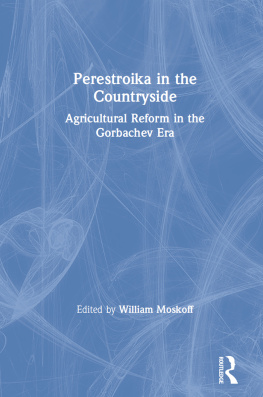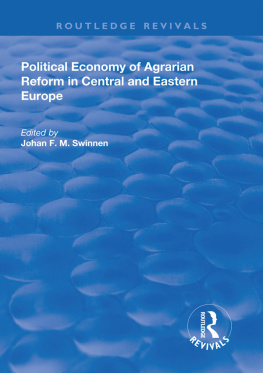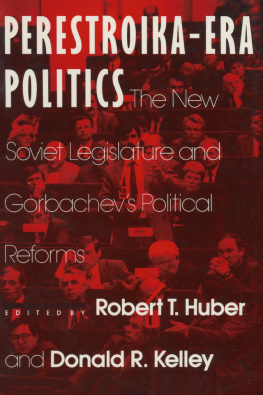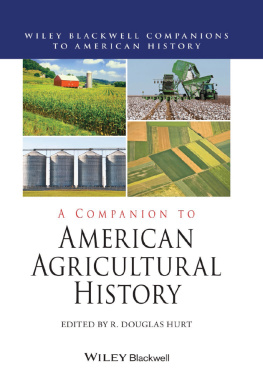PERESTROIKA
IN THE
COUNTRYSIDE
PERESTROIKA
IN THE
COUNTRYSIDE
Agricultural Reform in the Gorbachev Era
Edited by
William Moskoff
First published 1990 by M.E. Sharpe
Published 2015 by Routledge
2 Park Square, Milton Park, Abingdon, Oxon OX14 4RN
711 Third Avenue, New York, NY 10017, USA
Routledge is an imprint of the Taylor & Francis Group, an informa business
Copyright 1990 Taylor & Francis. All rights reserved.
No part of this book may be reprinted or reproduced or utilised in any form or by any electronic, mechanical, or other means, now known or hereafter invented, including photocopying and recording, or in any information storage or retrieval system, without permission in writing from the publishers.
Notices
No responsibility is assumed by the publisher for any injury and/or damage to persons or property as a matter of products liability, negligence or otherwise, or from any use of operation of any methods, products, instructions or ideas contained in the material herein.
Practitioners and researchers must always rely on their own experience and knowledge in evaluating and using any information, methods, compounds, or experiments described herein. In using such information or methods they should be mindful of their own safety and the safety of others, including parties for whom they have a professional responsibility.
Product or corporate names may be trademarks or registered trademarks, and are used only for identification and explanation without intent to infringe.
Library of Congress Cataloging-in-Publication Data
Perestroika in the countryside : agricultural reform in the Gorbachev era / William
Moskoff, editor.
p.cm.
ISBN 0-87332-767-5
1. Agriculture and stateSoviet Union. 2. Perestroika.. I. Moskoff, William.
HD1993.P471990
ISBN 13: 9780873327671 (hbk)
For my brother Michael and my sister Gail
Contents
William Moskoff
Gorbachev and Stolypin
Soviet Agrarian Reform in Historical Perspective
David A.J. Macey
Jim Butterfield
Reforming Soviet Agriculture
Problems with Farm Finances and Equity Considerations
Edward C. Cook
Karen Brooks
Full-Scale, Like Collectivization, but without Collectivizations Excesses
The Campaign to Introduce the Family and Lease Contract in Soviet Agriculture
Don Van Atta
D. Gale Johnson
Hungarian Agriculture
Lessons for the Soviet Union
Michael Marrese
About the Editor
WILLIAM MOSKOFF
In a recent Soviet political cartoon there is a picture of a glass, steam rising from its edges, obviously filled with a hot drink. Only the piece of paper hanging just as a tea bag would is labeled ration coupon for tea and there is another piece of paper at the bottom of the glass labeled, ration ticket for sugar.1 In another cartoon, a husband plaintively reports the results of his shopping trip to his confused wife: Again in the store there is only fillet of sturgeon and black caviar, but no matches or salt.2 And a starkly empty shelf in an absolutely empty food store bears a sign that says: Food for thought.3 These all can be summarized by the joke that circulated about a decade ago in Leningrad. Question: Is it possible for an elephant to get a hernia? Answer: Yes, if it tries to lift Soviet agriculture.4
Behind the whimsy of Soviet political humor lies a deadly serious problema shortage of food for a nation of 285 million people. Forty-five years after the end of World War II and more than thirty years since Sputnik was launched into space, the food situation for one of the superpowers has deteriorated to the point that in many places rationing has had to be instituted for a number of goods.
The failure of Soviet agriculture to feed its people is a function of several interrelated systemic problems. First, there is the issue of producing a sufficient quantity of food. Second, there is the question of being able to distribute the food that is produced. Finally, there is the issue of producing a balanced diet for the population. The sad and enduring fact is that Soviet agriculture has been unable to do a proper job in each of these areas. Indeed, in mid-March 1989 at a plenary session of the CPSU Central Committee, General Secretary Mikhail Gorbachev delivered a blistering attack on agriculture for failing to feed the nation. That meeting adopted a resolution calling for the end of Soviet food shortages within five to seven years.5 It is no wonder that Gorbachev criticized agriculture so severely. Agricultural production has been so dismal during his stewardship that per capita consumption actually fell for three consecutive years: by 3.2 percent in 1985, 7.7 percent in 1986, and 0.9 percent in 1987.6
Quite independent of production difficulties, a second major problem lies within the food distribution system. Detailed data for the first nine months of 1989 show that the amount of substandard and spoiled food as a proportion of all food delivered to the state retail trade network was 12 percent of potatoes, 18 percent of cabbages, 15 percent of onions, 30 percent of tomatoes, 23 percent of grapes, and 18 percent of melons.7 And this does not count all the undelivered food that rots out in the fields or in barns or at other points before it is actually delivered. For example, after the sugar beet harvest in September 1989, the beets were kept out in the open for two months before being delivered to factories for processing.8 Perhaps 30 percent or more of Soviet food never makes it from the field to the table of the ordinary citizen.
Thirdly, the Soviet diet, although generally adequate in caloric terms, does not provide an appropriate balance across the food groups, being chronically deficient in meat, milk, eggs, vegetables, and fruits.9
The root cause of all these problems is the economic system that has dominated Soviet agriculture in almost unchanging form for the sixty years since collectivization was instituted. In sum, that system is marked by a hierarchical command system in which farmers have been told what to produce and how to produce it. Moreover, the prices at which they have sold their output to the state never reflected underlying market conditions. Farmers did not follow market prices to determine how best to use land. Instead, prices were set by bureaucrats who often had no knowledge of what crops should be grown, and the Soviet system of procurements, mostly compulsory in nature, constituted a heavy tax on the peasantry. As a consequence, there was little incentive for farmers to maximize production. Additionally, agriculture has been hampered by an industrial system that has not produced the inputs to produce high levels of agricultural output. Thus, in spite of substantial investments in agriculture in the last two decades, yields remain extremely low by Western standards.
The seven papers in this volume focus on a set of problems and policies related to agricultural production. The papers are drawn from two panels on agriculture at the 1989 meetings of the American Association for the Advancement of Slavic Studies and they appeared (some of them in earlier versions) in the journal Comparative Economic Studies. The complexity of the agricultural dilemma is reflected in these works by scholars from the disciplines of economics, history, and political science. Historian David Macey, in the first paper, assesses the likelihood of success for Gorbachevs agricultural reforms in light of similar policies adopted during the tsarist period under the Stolypin reforms some eighty-five years ago. One of the key policies was the development of individual forms of agriculture to replace communal agriculture, a policy which is being pursued today. Political scientist Jim Butterfield demonstrates that there are several areas of potential conflict that impose themselves as obstacles to success in reforming agriculture. The problems arise, in the main, out of agricultures long-established command system. There are potential barriers at the republic level, where those who replaced the old ministerial system are now operating, and there is the incipient friction between the agricultural establishment and the party whose role in reform is not yet fully spelled out. Ed Cook defines a number of impediments to reform from an economists perspective. He argues that the planners have made an implicit social contract with the farmers, and equity considerations have made them reluctant to introduce policies that could lead to a more efficient agriculture. As a consequence, issues of land ownership and price reform have not been solved. Cook also raises the question of whether agricultural reforms to date have created incentives that are sufficient to motivate peasants to take up individual agriculture again.








